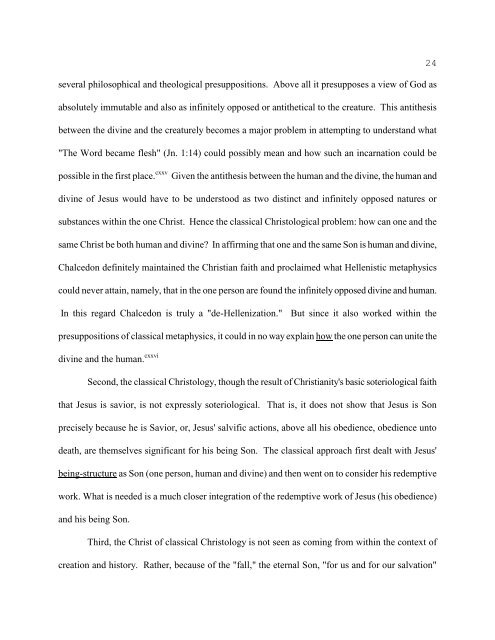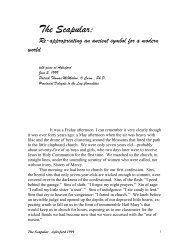Christocentrism of Charism – Buggert - CarmelStream
Christocentrism of Charism – Buggert - CarmelStream
Christocentrism of Charism – Buggert - CarmelStream
You also want an ePaper? Increase the reach of your titles
YUMPU automatically turns print PDFs into web optimized ePapers that Google loves.
several philosophical and theological presuppositions. Above all it presupposes a view <strong>of</strong> God as<br />
absolutely immutable and also as infinitely opposed or antithetical to the creature. This antithesis<br />
between the divine and the creaturely becomes a major problem in attempting to understand what<br />
"The Word became flesh" (Jn. 1:14) could possibly mean and how such an incarnation could be<br />
possible in the first place. cxxv Given the antithesis between the human and the divine, the human and<br />
divine <strong>of</strong> Jesus would have to be understood as two distinct and infinitely opposed natures or<br />
substances within the one Christ. Hence the classical Christological problem: how can one and the<br />
same Christ be both human and divine? In affirming that one and the same Son is human and divine,<br />
Chalcedon definitely maintained the Christian faith and proclaimed what Hellenistic metaphysics<br />
could never attain, namely, that in the one person are found the infinitely opposed divine and human.<br />
In this regard Chalcedon is truly a "de-Hellenization." But since it also worked within the<br />
presuppositions <strong>of</strong> classical metaphysics, it could in no way explain how the one person can unite the<br />
divine and the human. cxxvi<br />
Second, the classical Christology, though the result <strong>of</strong> Christianity's basic soteriological faith<br />
that Jesus is savior, is not expressly soteriological. That is, it does not show that Jesus is Son<br />
precisely because he is Savior, or, Jesus' salvific actions, above all his obedience, obedience unto<br />
death, are themselves significant for his being Son. The classical approach first dealt with Jesus'<br />
being-structure as Son (one person, human and divine) and then went on to consider his redemptive<br />
work. What is needed is a much closer integration <strong>of</strong> the redemptive work <strong>of</strong> Jesus (his obedience)<br />
and his being Son.<br />
Third, the Christ <strong>of</strong> classical Christology is not seen as coming from within the context <strong>of</strong><br />
creation and history. Rather, because <strong>of</strong> the "fall," the eternal Son, "for us and for our salvation"<br />
24



